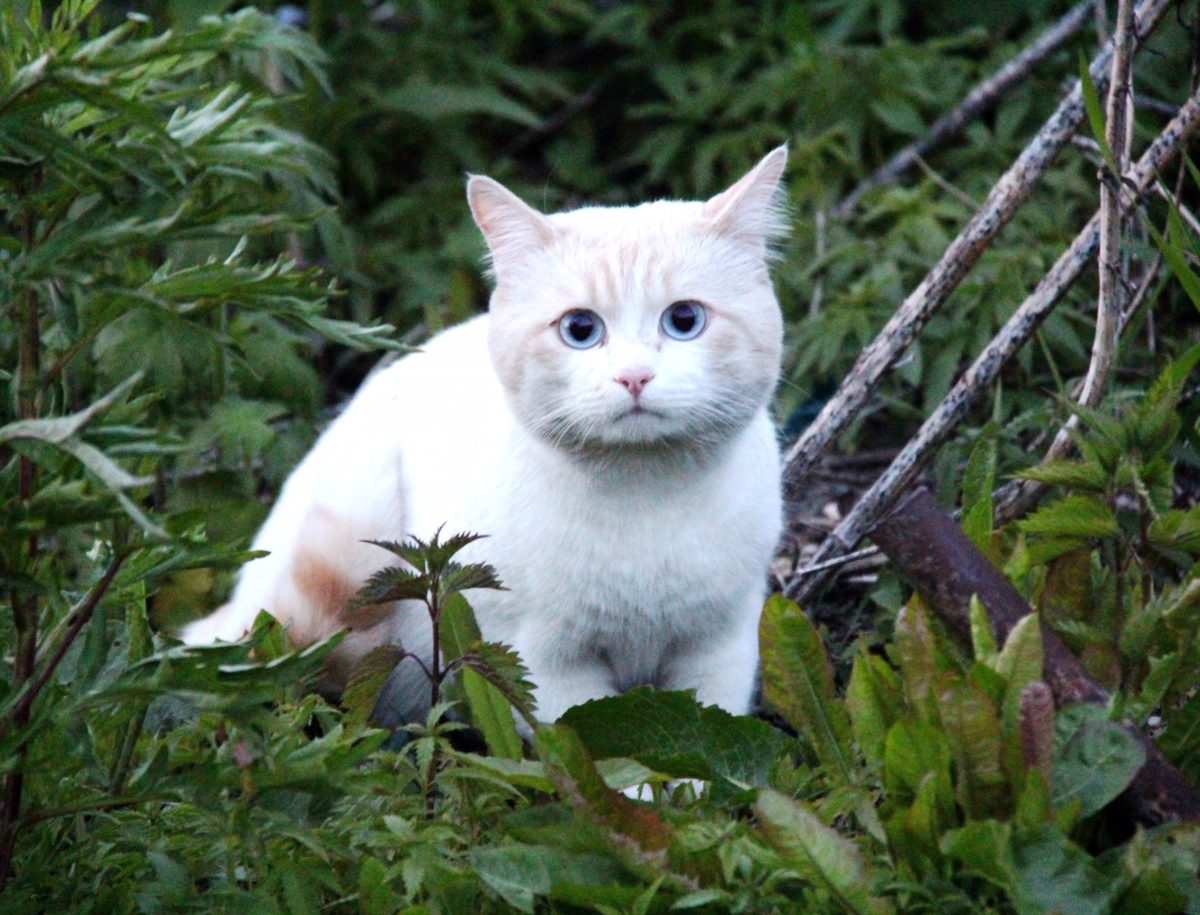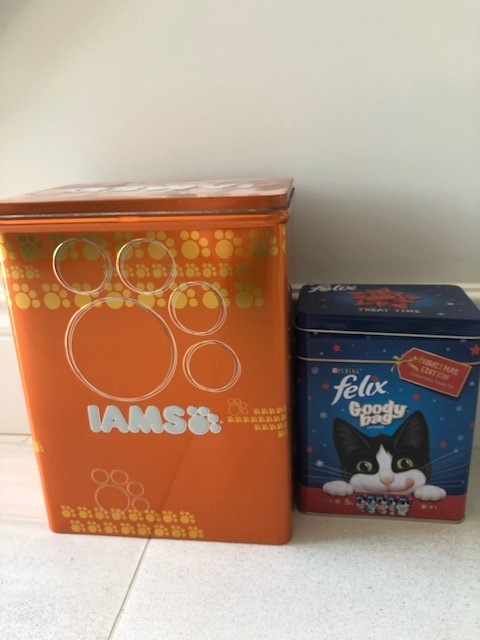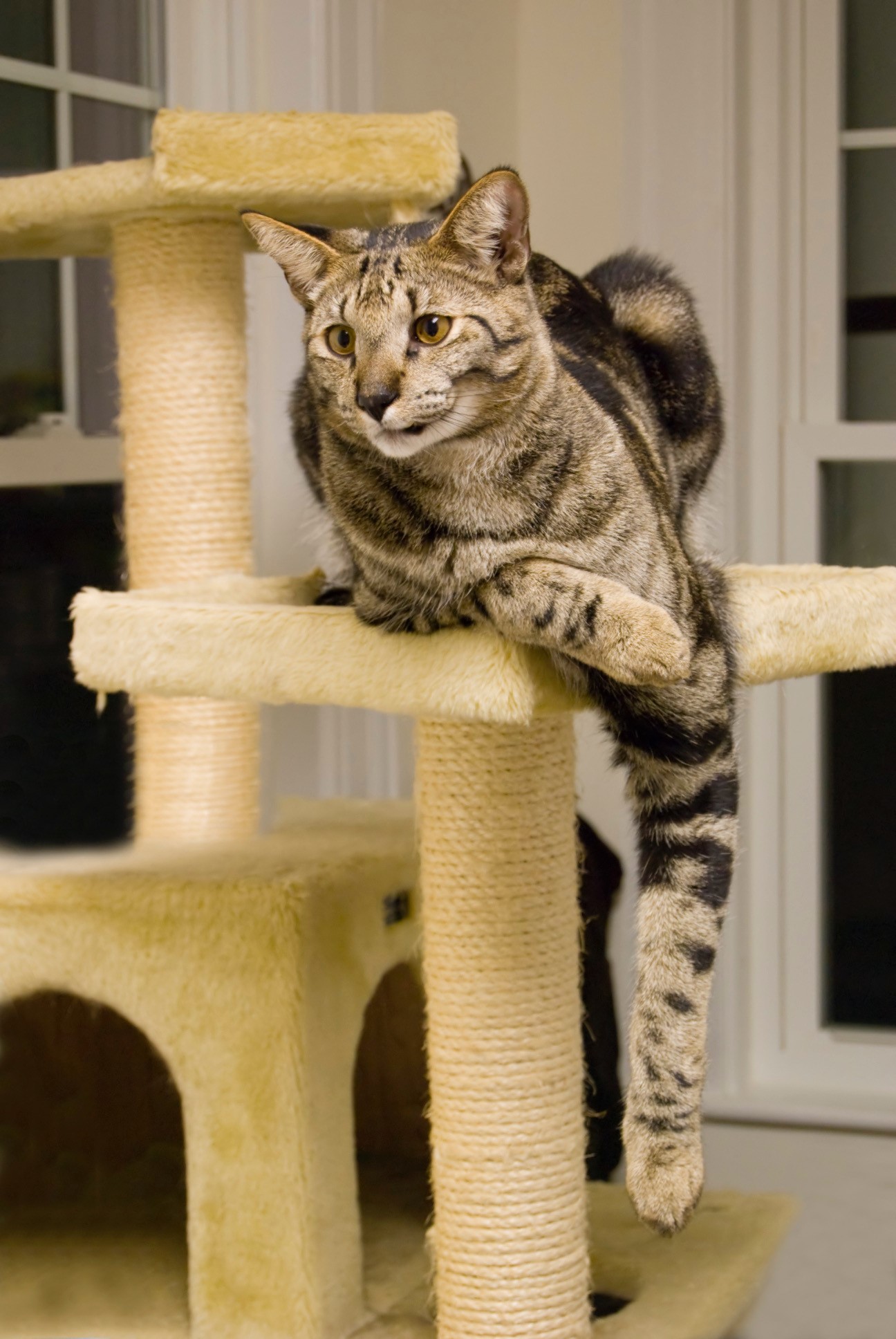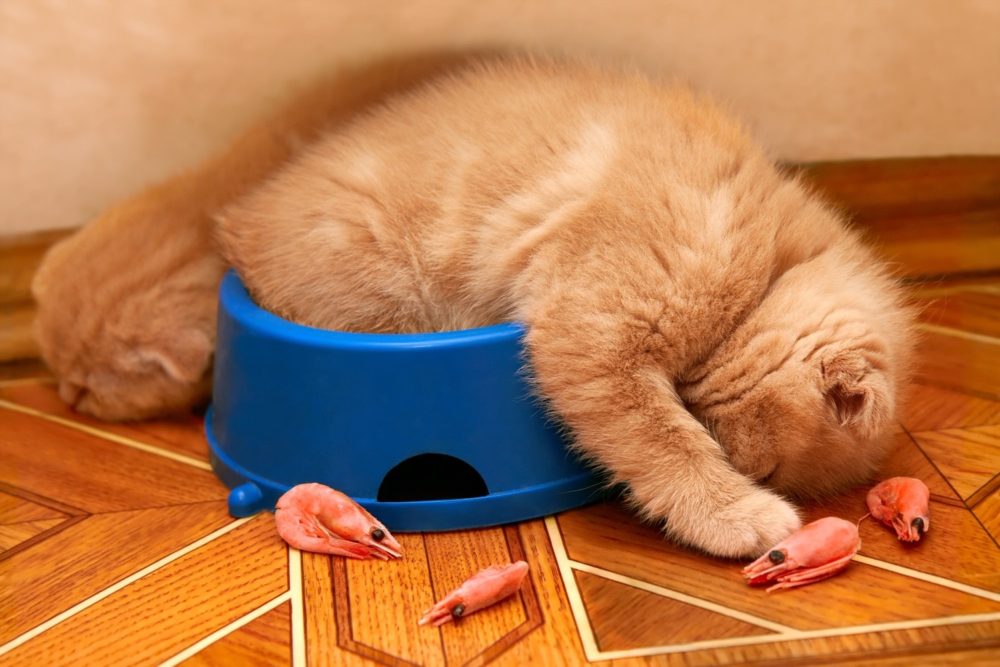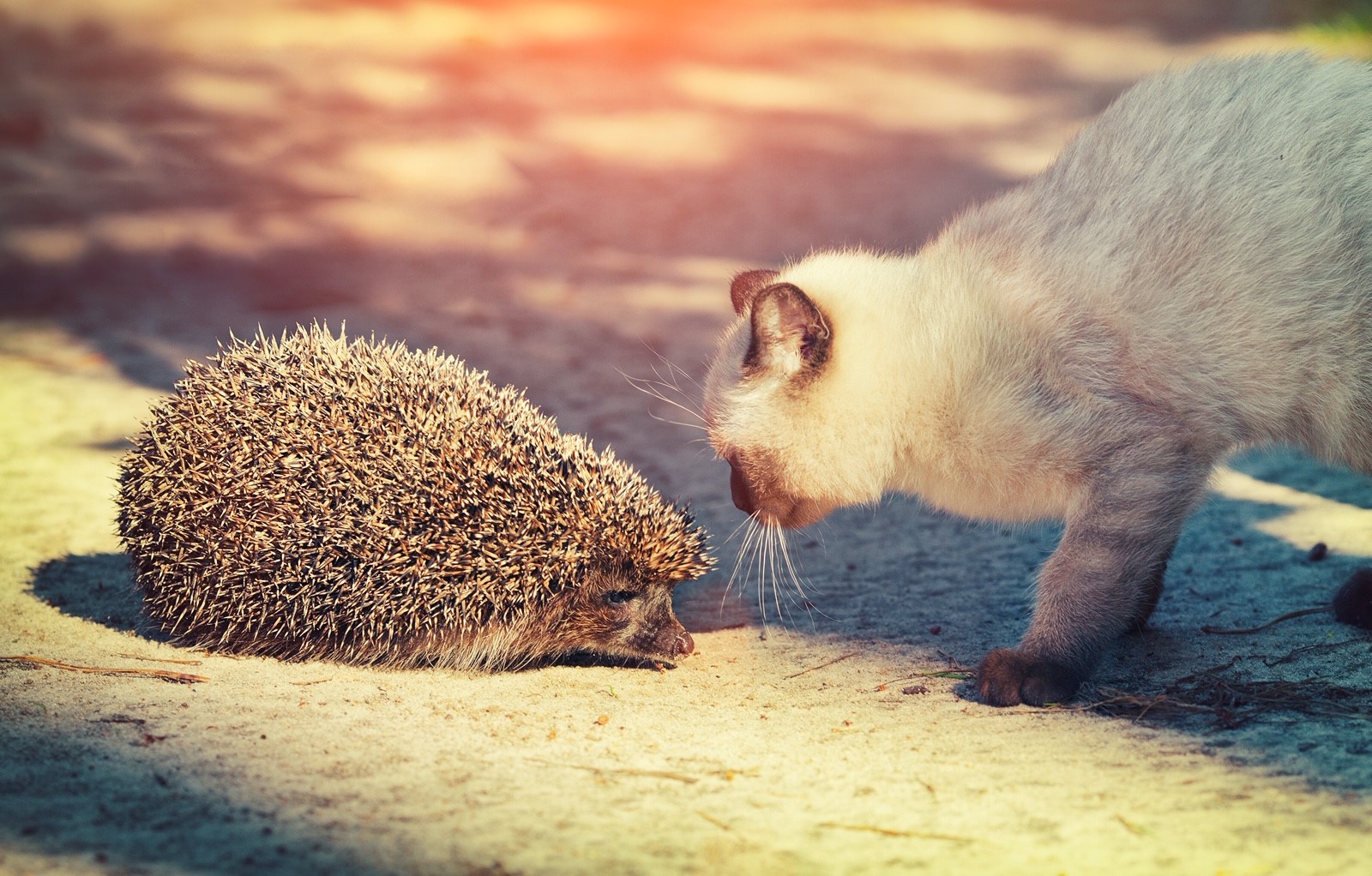
Cats and hedgehogs – a complete guide
The sheer joy and excitement we felt the other evening as we saw a hedgehog sniffing around our front door was fabulous. Our cat had left a couple of uneaten crunchy cat treats on the doorstep and it seemed Mr or Mrs hedgehog had sniffed out these tasty delights. As hedgehogs are nocturnal it is not common to see these fascinating creatures roaming around. But it did spark our curiosity about cats and hedgehogs? Our cats are indoors overnight but many cats are actively hunting outside from dusk onward. What would they make of these prickly mammals? Hopefully this article will answer many cat and hedgehog related questions that cat owners are asking.
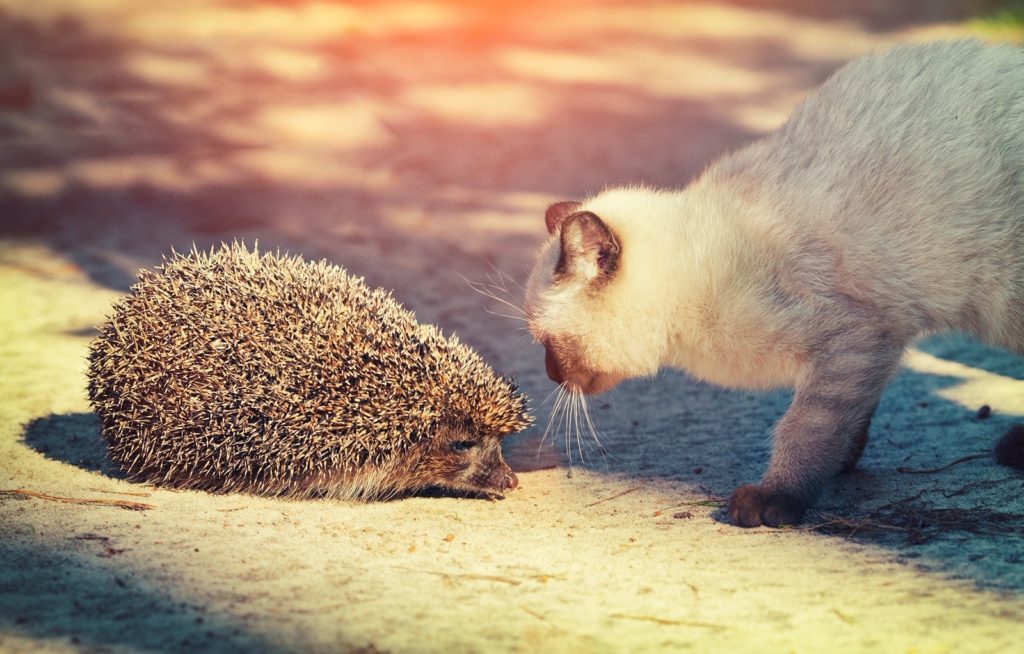
Will hedgehogs give my cat fleas?
It is well known that hedgehogs are more than likely to have fleas. The last thing any cat owner wants is for their cat to have fleas! So, can these prickly creatures give cats fleas? The simple answer is no – hedgehog cannot give your cat fleas. The hedgehogs found on fleas are specific hedgehog fleas. They will not survive on any other hosts – be that cats, dogs or any other species and humans.
Do hedgehogs and cats get along?
With their protective spikes, hedgehogs are more than capable of protecting themselves from an inquisitive cat. Likewise, cats soon develop the knowledge that staying away from this prickly creature is the best option. This mutual respect for keeping distance is likely to be the relationship between a cat and a hedgehog.
Can a cat kill a hedgehog?
As mentioned above, most cats will keep their distance from a hedgehog and its spikes. But it has been known for a cat to kill a hedgehog, albeit rare. This is much more likely to be a feral cat, hunting for food, rather than a domesticated cat whose hunting urges are more to do with the thrill of the chase and playing with their prey. Check out our article ‘What to do when your cat brings home a bird or a mouse’ to understand more about the hunting behaviours of cats.
Is hedgehog food bad for cats?
Many people feed cat food to hedgehogs. In fact, this is recommended by many hedgehog organisations as cat food, unlike commercially prepared hedgehog food, is regulated. Cat food is safe, produced in monitored, hygienic conditions with regulations on content and nutrition. This will provide all the nutrition and benefit that a hedgehog will need. There are many types of hedgehog foods also available to buy. These will not cause harm to your cat if eaten. It does seem much easier and more accessible to feed cat food to both cats and hedgehogs. The key factor is keeping their feeding stations separate to minimize disease and to ensure there is enough for everyone!
How can I feed a hedgehog and not a cat?
The aim is to provide a feeding station that only your hedgehog can access. There are various hedgehog feeding stations and hedgehog homes available to purchase ready made. This cute little home by CKB Ltd would be sure to please any little hedgehog seeking shelter.

If you have seen our article ’10 ways to become a green, environmentally friendly cat owner’ you’ll know that we simply love recycling and up-cycling things that we already have. It is so easy to make your own hedgehog feeding station. In this design we simply used some bricks, wood, and some slate to keep it dry. The entrance to the feeding station should be large enough for hedgehogs but too small for cats. As hedgehogs aren’t very sociable animals, it is best to provide a separate exit doorway to the feeding station. They are usually solitary and courteous creatures, and if another hedgehog enters the station for some food, it is likely the feeding hedgehog will simply turn and leave through the other exit.

A similar concept can be built using a plastic container, either with the lid on, or overturned to keep the food and shelter dry. Again, make 2 holes, approximately 12 cms, for hedgehog access.
As cat owners, we are well aware of how flexible cats can be, and how they can crawl through fairly small spaces at times. A top tip is to place a shallow bowl of water by the hedgehog feeding station entrance. Cats will probably not bother if they find they have to stretch through a bowl of water to get to the food source. Mr or Mrs hedgehog, however, will have no qualms in stepping through a bowl of water to feast on the taste delights in the station.
To determine with certainty what is eating the ‘hedgehog food’ it is now relatively cheap and easy to set up a night vision wildlife camera. As we drift off to the land of dreams for the night, a whole new other world awakens in the animal kingdom. Observing their adventures without disturbing them is simply pure joy. This APEMAN trail camera is great for recording both photographs and videos of any activity in garden. It is waterproof, dust proof and doesn’t give off a bright light at night which may disturb the animals.
Can my cat catch anything from hedgehogs?
Hedgehogs can carry various strain of the bacterium Salmonella. The disease, Salmonellosis can affect birds, mammals and reptiles. Some hedgehogs in Europe, including the UK, have been found to be carrying strains of Salmonella. The bacteria can be transferred through bacterium in the food and water sources, infected faeces, and open wounds. The risk of hedgehogs passing the disease to cats, and other pets, is rare. If you have any concerns regarding your pets health please do not hesitate to contact your veterinary for advice.
The following tips are helpful in minimizing the risk of the transmission of disease from hedgehogs to cats:
- Use separate feeding bowls for your cats and any hedgehogs that you may be feeding.
- If you find a dead or poorly hedgehog, contact your local wildlife center or hedgehog rescue center.
- If you need to handle a hedgehog, always use gloves. Rubber gloves or thick gardening gloves are best. Always wash your hands thoroughly afterwards.
- Always clean thoroughly any feeding surfaces or bowls that hedgehogs use. Please check manufacture’s guidelines as to what disinfectant is suitable. Keep any cloths or brushes used outside and clean these thoroughly too. Allow all cloths, bowls, plates and surfaces to dry before next use.
Hedgehog facts
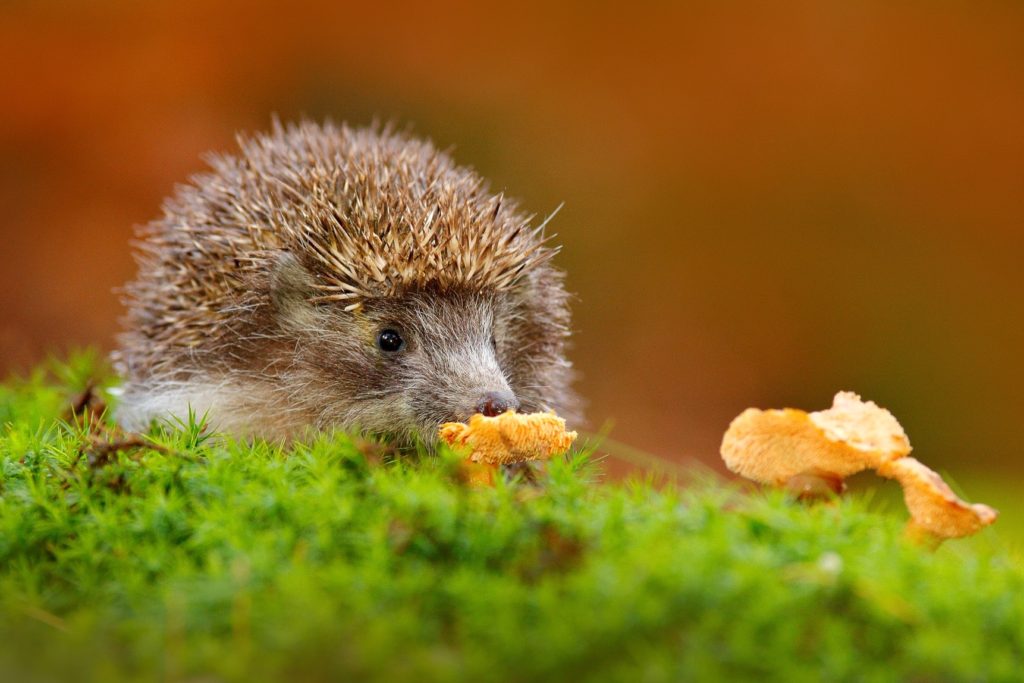
And finally, here are some interesting facts about our prickly little mammal friends:
- Hedgehogs are nocturnal. To see one out in the day usually means it is poorly or injured. The best advice is to seek help from a nearby animal or rescue hedgehog center.
- Between November and March, hedgehogs usually hibernate although they do wake up at least once during hibernation to move their nest.
- Like our cats, hedgehogs are lactose intolerant. Leaving water out for them to drink is much better for their health.
- Hedgehogs have finely tuned hearing and smell senses which are used to hunt out slugs, beetles, caterpillars and earthworms – and cat food!
- They can travel up to 2 miles foraging for food at night-time.
- There are between 5000 and 7000 spikes on a hedgehog. These spikes do fall out but a new one will grow in its place. A spike will usually last about 12 months before falling out. The spikes are not poisonous and are not barbed.
- There are 17 different species of hedgehogs found around the world. They are not native to America, Australia or New Zealand. It is humans that introduced the hedgehogs to these countries.
______________________________________________________________________________________________________________________________________
Other articles you may find of interest:
A Guide to Dry cat food storage, Wet cat food storage & Cat treats storage
Do cats eat rabbits? Can cats and rabbits get along?
Are ponds safe for cats? Can cats drink pond water?
Do cats keep rats away? Do cats hunt rats?
Can cats get fleas from mice? Homeopathic & natural remedies for cat fleas
